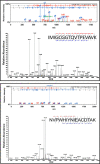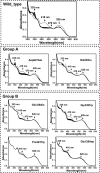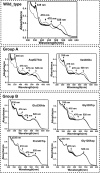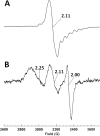A conformational sampling model for radical catalysis in pyridoxal phosphate- and cobalamin-dependent enzymes
- PMID: 25213862
- PMCID: PMC4256349
- DOI: 10.1074/jbc.M114.590471
A conformational sampling model for radical catalysis in pyridoxal phosphate- and cobalamin-dependent enzymes
Abstract
Cobalamin-dependent enzymes enhance the rate of C-Co bond cleavage by up to ∼10(12)-fold to generate cob(II)alamin and a transient adenosyl radical. In the case of the pyridoxal 5'-phosphate (PLP) and cobalamin-dependent enzymes lysine 5,6-aminomutase and ornithine 4,5 aminomutase (OAM), it has been proposed that a large scale domain reorientation of the cobalamin-binding domain is linked to radical catalysis. Here, OAM variants were designed to perturb the interface between the cobalamin-binding domain and the PLP-binding TIM barrel domain. Steady-state and single turnover kinetic studies of these variants, combined with pulsed electron-electron double resonance measurements of spin-labeled OAM were used to provide direct evidence for a dynamic interface between the cobalamin and PLP-binding domains. Our data suggest that following ligand binding-induced cleavage of the Lys(629)-PLP covalent bond, dynamic motion of the cobalamin-binding domain leads to conformational sampling of the available space. This supports radical catalysis through transient formation of a catalytically competent active state. Crucially, it appears that the formation of the state containing both a substrate/product radical and Co(II) does not restrict cobalamin domain motion. A similar conformational sampling mechanism has been proposed to support rapid electron transfer in a number of dynamic redox systems.
Keywords: Adenosylcobalamin (AdoCbl); Conformational Sampling; Domain Dynamics; Electron Paramagnetic Resonance (EPR); Ornithine Aminomutase; Protein Dynamic; Pyridoxal Phosphate; Radical.
© 2014 by The American Society for Biochemistry and Molecular Biology, Inc.
Figures











Similar articles
-
Glutamate 338 is an electrostatic facilitator of C-Co bond breakage in a dynamic/electrostatic model of catalysis by ornithine aminomutase.FEBS J. 2015 Apr;282(7):1242-55. doi: 10.1111/febs.13215. Epub 2015 Feb 12. FEBS J. 2015. PMID: 25627283 Free PMC article.
-
Large-scale domain dynamics and adenosylcobalamin reorientation orchestrate radical catalysis in ornithine 4,5-aminomutase.J Biol Chem. 2010 Apr 30;285(18):13942-50. doi: 10.1074/jbc.M109.068908. Epub 2010 Jan 27. J Biol Chem. 2010. PMID: 20106986 Free PMC article.
-
Isotope effects for deuterium transfer and mutagenesis of Tyr187 provide insight into controlled radical chemistry in adenosylcobalamin-dependent ornithine 4,5-aminomutase.Biochemistry. 2014 Aug 26;53(33):5432-43. doi: 10.1021/bi5006706. Epub 2014 Aug 18. Biochemistry. 2014. PMID: 25100213
-
Large-scale domain motions and pyridoxal-5'-phosphate assisted radical catalysis in coenzyme B12-dependent aminomutases.Int J Mol Sci. 2014 Feb 20;15(2):3064-87. doi: 10.3390/ijms15023064. Int J Mol Sci. 2014. PMID: 24562332 Free PMC article. Review.
-
Pyridoxal-5'-phosphate as the catalyst for radical isomerization in reactions of PLP-dependent aminomutases.Biochim Biophys Acta. 2011 Nov;1814(11):1548-57. doi: 10.1016/j.bbapap.2011.03.005. Epub 2011 Mar 22. Biochim Biophys Acta. 2011. PMID: 21435400 Review.
Cited by
-
Glutamate 338 is an electrostatic facilitator of C-Co bond breakage in a dynamic/electrostatic model of catalysis by ornithine aminomutase.FEBS J. 2015 Apr;282(7):1242-55. doi: 10.1111/febs.13215. Epub 2015 Feb 12. FEBS J. 2015. PMID: 25627283 Free PMC article.
References
-
- Brown K. L. (2005) Chemistry and enzymology of vitamin B12. Chem. Rev. 105, 2075–2149 - PubMed
-
- Marsh E. N. (1995) A radical approach to enzyme catalysis. Bioessays 17, 431–441 - PubMed
-
- Roth J. R., Lawrence J. G., Bobik T. A. (1996) Cobalamin (coenzyme B12): synthesis and biological significance. Annu. Rev. Microbiol. 50, 137–181 - PubMed
-
- Stubbe J. A. (1989) Protein radical involvement in biological catalysis? Annu. Rev. Biochem. 58, 257–285 - PubMed
-
- Marsh E. N., Ballou D. P. (1998) Coupling of cobalt-carbon bond homolysis and hydrogen atom abstraction in adenosylcobalamin-dependent glutamate mutase. Biochemistry 37, 11864–11872 - PubMed
Publication types
MeSH terms
Substances
Grants and funding
LinkOut - more resources
Full Text Sources
Other Literature Sources
Research Materials

